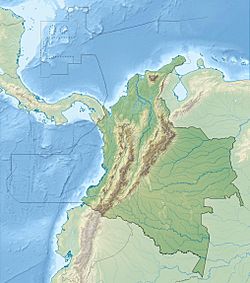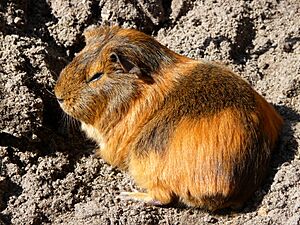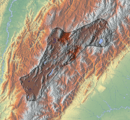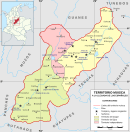Checua facts for kids
| Location | Nemocón, Cundinamarca |
|---|---|
| Region | Bogotá savanna Altiplano Cundiboyacense |
| Coordinates | 5°07′12.1″N 73°52′35.3″W / 5.120028°N 73.876472°W |
| Altitude | 2,577 m (8,455 ft) |
| Type | Open area settlement |
| Part of | Pre-Muisca sites |
| History | |
| Periods | Preceramic |
| Cultures | Preceramic |
| Site notes | |
| Archaeologists | Ana María Groot |
Checua is an ancient open-air site in Colombia. It's a place where archaeologists found clues about people who lived there long, long ago. The site is located about 7 kilometers (4 miles) north of Nemocón town in Cundinamarca.
Archaeologists found thousands of old tools made of stone and bone at Checua. They also found human remains. This tells us that people lived here from about 8,500 to 3,000 years ago. A main archaeologist, Ana María Groot, studied Checua. She shared her findings in 1992.
Contents
Discovering Checua
The high plains of Altiplano Cundiboyacense have been home to people for at least 12,500 years. The first people arrived from Central America. They were hunter-gatherers, meaning they hunted animals and gathered plants for food.
These early people lived in rock shelters in the Andes mountains. Back then, huge animals like mammoths and giant sloths roamed the land. Over time, people started moving from rock shelters to open areas. Checua is one of the oldest open-air settlements found. Other similar sites include Galindo and Aguazuque.
Later, around 2,000 years ago, more people lived in the area. Their settlements grew bigger. This is shown by discoveries near the ancient salt mine in Nemocón.
What the Site Looks Like
Checua is located in a valley on the Altiplano Cundiboyacense. The area has many salt mines, like those in Nemocón, Zipaquirá, and Tausa. The land around Checua is hilly with flat valleys.
The weather in Checua stays pretty much the same all year. The average high temperature is about 22°C (71°F). The average low is about 3°C (37°F). It rains about 600 to 750 millimeters (24 to 30 inches) each year. The winds can be strong, which helps shape the land.
The area used to have a dry forest. Some of the plants that grew there include Dodanae viscosa, Baccharis sp., and Lupinus sp..
Tools and Discoveries
Archaeologists divided the Checua site into nine layers of sand and clay. They found many interesting things in these layers.
Stone Tools
More than 1,750 stone tools were found at Checua. Most of these tools were scrapers and knives. These were likely used for preparing meat or animal skins. Archaeologists also found over 2,800 stone flakes. These flakes were probably leftover pieces from making tools.
Bone Tools
Many tools made from bone were also discovered at Checua. These bone tools are very similar to those found at other ancient sites like Aguazuque and Tequendama.
Besides tools, a special musical instrument made from bone was found. It was a bone flute. This flute was discovered about 60 centimeters (2 feet) deep in one of the layers.
Human Remains
Scientists studied the tooth enamel from some human remains found at Checua. They used a special method to find out how old the teeth were. One tooth was about 7,850 years old. Another tooth was about 5,021 years old. This helps us understand when people lived at the site.
How People Lived at Checua
By studying the different layers and tools, archaeologists learned about four main periods of human life at Checua. These periods cover about 5,500 years, from 6500 to 1000 BCE.
- First Period: Around 8,500 to 8,200 years ago. People mainly used scrapers and tools for working with meat and animal skins.
- Second Period: From about 8,200 to 7,800 years ago. This period includes several burial sites. More scrapers and tools were found here. The main foods for people at this time were white-tailed deer and guinea pigs. The bone flute was found in this layer.
- Third Period: This layer has many bone fragments. It is thought to be from around 5,000 to 4,000 years ago.
- Fourth Period: The top layer has been disturbed by modern farming. It also contains glass, which means it has more recent items mixed in. It's believed people lived here until about 3,000 years ago.
| Timeline of inhabitation of the Altiplano Cundiboyacense, Colombia | |
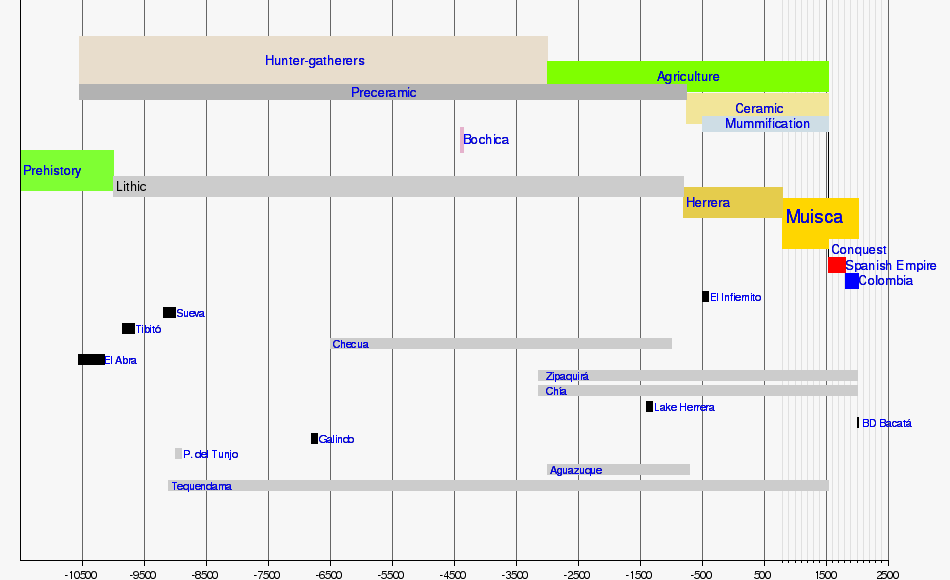 |
|


